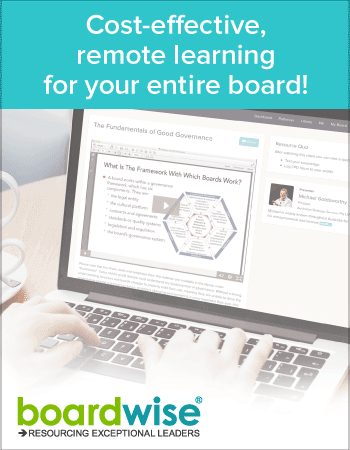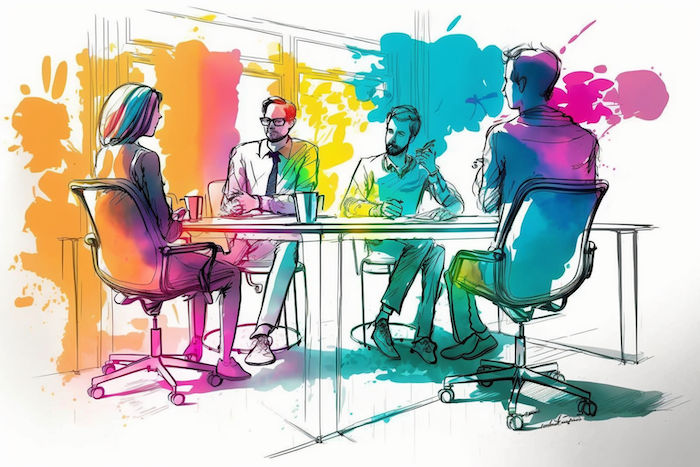Run a Board Meeting that's Effective and Productive
-
meetings
Run a Board Meeting that's Effective and Productive
Effective board meetings are crucial to the effectiveness of the board of directors and to the future success of every organisation. Here are some tips on how you can ensure that you run effective meetings. Incorporating the below ideas should contribute to creating effective meetings that will help your organisation flourish.
Set a Clear Agenda
A well written, clear and comprehensive agenda is the backbone of any meeting and board meetings are no exception. An effective meeting agenda should utilise an agenda template and contain all relevant meeting information including discussion points, action items and the time allocated for each item.
Ensure that the meeting agenda is distributed to all participants at least a minimum of 7 days in advance of the board meeting. This gives board directors time to digest the agenda and its associated meeting or board pack and the opportunity to seek clarification or provide feedback in advance of the meeting. It means directors can arrive at the meeting well prepared and that there shouldn’t be any surprises.
Be Punctual
Arriving late was a way of saying that your own time was more valuable than the time of the person who waited for you. – Karen Joy Fowler
Everyone is busy and has matters other than board business in their lives to deal with. Starting and ending each board meeting at the allotted times, whether everyone has arrived or not, has many benefits. The main three benefits of starting a meeting on time are that it helps to:
- demonstrate respect for the participants’ schedules
- maintain the meeting’s momentum.
- set the expectation to the entire board that they need to be on-time (or early) and prepared to participate.
To ensure the meeting starts on time you need to encourage attendees to arrive early and ensure that there is plenty of time dedicated before the meeting to setting up any technology, or materials, thus avoiding unnecessary delays.
Time management
Time management within a meeting is key to an effective meeting and can make all the difference to the ability of the board to have time for strategic discussions and strategic decision making.
Ensure that you have allocated sufficient time for each agenda item and that the meeting progresses at a reasonable pace. This can be achieved through the use of:
- time limits set on the agenda itself
- gentle reminders
- an appointed timekeeper (ideally the chair and not the minute taker either)
Appropriate meeting setting
The location of an in-person board meeting is typically chosen for convenience. The space used is one that an organisation has easy or free access to. However thought should be given to whether the space will contribute to effective meetings.
Fostering a productive and comfortable atmosphere for your board meetings is an area of effective meeting design that can be overlooked because the impact of the environment on the meeting is not always obvious. When choosing a place to hold your board meetings, choose an environment and set up that will be conducive to an effective meeting.
The space should:
- have very few distractions,
- be well lit,
- comfortable (not not too comfortable - we don’t want members falling asleep)
- have enough space allow a seating configuration where everyone can see each other and participate
- have amenities required for attendees
If you are holding digital meetings then the considerations are different but do share some similarities. The primary issue with digital meetings in regards to space and meeting effectiveness is managing and minimising distractions. You may well remember the case of the councillor in New Zealand who was caught dusting his bookshelves during a council meeting (without pants as well). While a highly amusing episode it also shows how easy it is to be distracted from a digital meeting and how important it is even with digital meetings to ensure that the environment is distraction free.
Concise presentations
Ensure that any presentations made during the meeting are well-prepared and to the point, leaving more time for more strategic discussion and decision making.
Careful time allocation is one important contributor to concise presentation. Another is respectful but firm timekeeping.
Providing presentation templates and guidance on expectation and best practices to those who will be presenting to the board is also worthwhile. Ultimately the meeting convenor or company secretary should be working with presenters to help them craft clear and concise presentations and understand the board’s expectations around presentations.
Structure Time for Strategic Decision Making
The holy grail of effective board meetings is carving plenty of out time for directors to engage in strategically focused discussion and strategic decision making. While a clear agenda is one way to help this, an even more effective way is to entirely restructure your agenda to be strategically focused.
The use of a Consent Agenda is an increasingly popular way to achieve this. Sometimes called a Strategic Board Agenda, the consent agenda methodology is not new but it has long been overlooked. The basic idea of the Consent Agenda is to take routine items and bundle them into a single “super vote” item so they can all be passed in a single motion. Then the remainder of the meeting can be devoted to issues, discussions and decisions that align to the strategic priorities of the organisation rather than routine approvals.
Another method for ensuring a meeting is focused on strategic priorities is to consider having each meeting devoted to a specific strategic priority. This is a “focus on the few” method, so you stop trying to do too many things with any given meeting.
An organisation is often going to have a handful of strategic priorities that align to its strategic plan. Placing one and only one of these strategic priorities at the top of the Agenda (in the header or pre-agenda blurb) so it is clear that this meeting is going to be focused on that specific strategic priority can help keep a board meeting focused and on track. It provides an anchor so that the chair or others can bring the meeting back to that specific priority should it veer off topic, which meetings so often can without anyone meaning them to.
Clear action items
To ensure that decisions are implemented and things actually get done ensure that your minute taker is capturing action items throughout the discussion to assign to the relevant board members or executives.
The action item descriptions, like minutes, should be clear and concise. This allows the person or group the action is assigned to, to know what they need to do and when it needs to be done. Tools like the Our Cat Herder Actions Tracker can be hugely beneficial in this respect as they allow easy assignment and communication on action items, while also enhancing accountability and transparency.
Seek feedback & Iterate
There is no one magic meeting structure that will automatically make your board meetings more effective or productive. However, through an iterative process (don’t make all the changes at once) you can improve and refine until your meetings are more effective. Measuring if your board meetings are effective is relative to the current state of your meetings and how effective you and your board believe they are.
Regularly undertaking a short evaluation of each meeting can help you stay on the pulse of changes in sentiment in the board or issues as they crop up rather than waiting for the full annual review to roll around.
An effective post meeting survey should be:
- Simple - don’t ask too many questions -Standardised - if you keep changing the questions you ask too frequently you may miss something and or you won’t be able to track trends.
Using a scale of poor to excellent you could ask:
- Please rate the effectiveness of the agenda and use of time per agenda item
- Please rate performance of the chair in this meeting.
- Did you feel that all board member were well prepared for the meeting?
Have board members complete (anonymously) at the end of each meeting. Ensure you collate the results across time to spot changes or trends. Then make changes.
Resources
What are the elements of a good board meeting?
Board Meeting Mastery: How Should a Chairperson Run the Meeting?
Three Ingredients for Meetings: Agendas, Minutes and Follow up Actions



